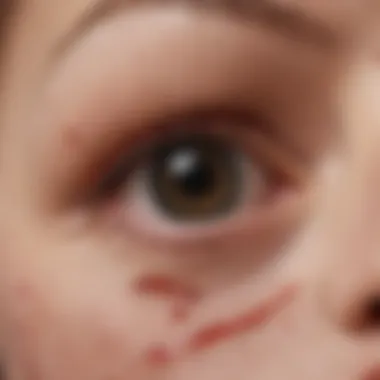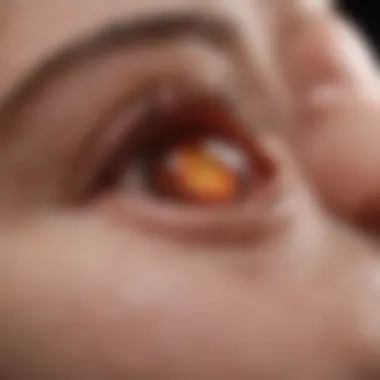Understanding Granuloma Annulare: A Comprehensive Overview


Intro
Granuloma annulare is a condition that often confounds both patients and practitioners alike. It presents as ring-shaped lesions, typically on the hands and feet. These lesions can sometimes resemble other dermatological issues such as tinea corporis or even psoriasis. Despite its benign nature, the mystique surrounding granuloma annulare persists due to unclear etiology and variable clinical presentations. This overview aims to dissect the multifaceted aspects of this condition, enlightining professionals and interested individuals about its characteristics and implications.
Research Overview
Summary of Key Findings
Recent literature emphasizes several compelling observations regarding granuloma annulare. Studies suggest that immunological factors may play a role in its development. Other reserach indicates a link between this condition and environmental triggers, such as infections or insect bites. However, the connections are not definitive. Thus far, the common themes observed include:
- A predominance in children and young adults.
- A tendency for self-resolution over time.
- An association with certain systemic diseases, although the exact correlation remains unclear.
Importance of the Research in Its Respective Field
Understanding granuloma annulare is critical not only for dermatologists but for general practitioners as well. As this condition may mimic other diseases, misdiagnosis can occur easily. Comprehensive research into granuloma annulare could enhance diagnostic accuracy, leading to more effective management and treatment. Furthermore, recognizing its potential associations with systemic illnesses is vital for comprehensive patient care.
Methodology
Description of the Experimental or Analytical Methods Used
To investigate granuloma annulare, researchers often employ a mix of histopathological examination and clinical evaluations. Biopsies of the affected skin can reveal hallmark findings such as a slight to moderate dermal infiltrate of histiocytes. In some studies, non-invasive techniques like dermoscopy are also explored to characterize lesions in real-time.
Sampling Criteria and Data Collection Techniques
Sample selection usually targets individuals presenting with ring-shaped lesions in outpatient dermatology clinics. Patients are typically asked to provide a thorough medical history. Data is gathered through direct clinical examination along with patient questionnaires. These methods help ensure that findings are both relevant and representative of broader patient experiences.
Intro to Granuloma Annulare
Granuloma annulare represents a fascinating subject within dermatology, drawing interest from both practitioners and researchers. This section is vital as it lays the groundwork for a thorough comprehension of the condition. By examining the fundamental aspects of granuloma annulare, we highlight the significance of the condition and its potential implications for patient health and well-being.
Definition and Overview
Granuloma annulare is a benign dermatological disorder characterized by ring-shaped lesions that can appear on the skin, often without any accompanying symptoms such as itching or pain. These lesions may vary in size and shape, typically manifesting as raised areas that can range in color from skin-toned to reddish or purplish hues. While the precise etiology remains unclear, various hypotheses suggest a relationship to autoimmune responses, infections, or environmental factors.
The overall impact of granuloma annulare on an individual’s quality of life can be minimal, yet it can still trigger concern due to its visible nature. Patients may seek treatment not merely for medical relief but also for cosmetic reasons. Understanding the condition is not only critical for healthcare professionals but also for patients who wish to make informed decisions about management options.
Historical Context
The historical narrative of granuloma annulare is both intriguing and enlightening. Early references can be found in medical literature dating back to the 19th century. The condition was first comprehensively described by the French dermatologist Félix Follin in 1890. Since then, the understanding of granuloma annulare has evolved significantly.
Over the years, scholars have proposed various theories regarding its cause, with changing perspectives reflecting broader trends in dermatological research. In the mid-20th century, granuloma annulare was often associated with systemic diseases, leading to a phase of intensive studies aimed at uncovering potential links with conditions such as diabetes mellitus and thyroid disorders.
Presently, we stand at a juncture where extensive research continues to explore its pathophysiology and optimal treatment protocols. Despite its benign nature, important questions remain regarding its underlying mechanisms and the reasons for its periodic reoccurrence in some individuals. As we delve deeper into this article, we will uncover these aspects, offering a more holistic view of granuloma annulare.
Clinical Presentation
Understanding the clinical presentation of granuloma annulare plays a vital role in diagnosing and managing the condition. Symptoms manifest primarily through distinct skin lesions, which are the most recognizable signs. Clinicians rely heavily on the characteristics of these lesions to differentiate granuloma annulare from other dermatological disorders. The importance of identifying the clinical traits can lead to appropriate treatment strategies and better patient outcomes. Moreover, awareness of various presentation forms helps professionals to conduct comprehensive evaluations and engage in informed discussions with patients.
Common Symptoms
Granuloma annulare typically presents with several common symptoms that can aid in diagnosis. The most notable symptom is the appearance of ring-shaped lesions on the skin with a raised border. These lesions can vary in color, often appearing red or skin-toned, and may also be itchy or asymptomatic. Other symptoms may include:
- Lesion Location: Typically found on the hands, feet, and other exposed areas.
- Size Variation: Lesions can range from small spots to large rings.
Understanding these symptoms provides a clearer picture of the condition and assists clinicians in evaluating the situation accurately.


Variants of Granuloma Annulare
Granuloma annulare is not a singular entity; it presents itself in various forms. The recognition of these variants is essential for effective diagnosis and treatment. Each variant has unique characteristics that influence management strategies.
Localized Granuloma Annulare
This variant is characterized by a limited number of lesions, usually found in a specific area of the body. Its contribution to the broader understanding of granuloma annulare is significant due to its frequent self-resolution. Localized granuloma annulare mainly occurs in children and healthy adults. Its distinct, well-defined rings make it easy to identify, making it an informative choice for this article. The unique feature of localized granuloma annulare is its tendency to resolve without treatment, which can be a benefit for patients. However, it may also necessitate monitoring to rule out other conditions.
Generalized Granuloma Annulare
Generalized granuloma annulare presents with multiple lesions covering a broader area of the skin. This variant is more prevalent among adults, adding complexity to its management due to its wider distribution and potential chronicity. Its key characteristic is the possibility of associated systemic issues, making it a significant focus for this article. The unique feature of generalized granuloma annulare is that it might require systemic treatments, which also carries disadvantages such as potential side effects and longer treatment duration.
Papular Granuloma Annulare
Papular granuloma annulare is identified by small, elevated bumps that may look similar to acne or other lesions. This variant is less common but important due to its distinct appearance and propensity to affect a younger demographic. The key characteristic, being papular, differentiates it from other types. The unique feature of this variant is its potential for misdiagnosis, which can delay proper treatment, underscoring its relevance in understanding granuloma annulare.
Demographics and Epidemiology
Demographics and epidemiology are crucial components that help in gaining insights into granuloma annulare. This condition predominantly affects children and young adults but can occur at any age. Studies show that there is a slight female predominance.
Understanding the demographics aids in recognizing patterns, possible risk factors, and necessary preventive measures. Awareness of the epidemiological data enhances the knowledge base for practitioners, leading to more effective approaches in managing granuloma annulare.
Etiology and Pathophysiology
Understanding the etiology and pathophysiology of granuloma annulare is crucial for several reasons. First, recognizing the underlying causes allows for more targeted therapeutic strategies. Second, this knowledge aids in differentiating granuloma annulare from other dermatological conditions with similar presentations. Lastly, insights into the cellular and immunological aspects contribute to the broader understanding of skin disorders in general.
Investigating Potential Causes
Genetic Factors
Genetic factors potentially play a significant role in the development of granuloma annulare. Familial cases suggest an inherited disposition, indicating that certain genetic markers might connect to the condition. One key characteristic of genetic factors is that they can provide a foundation for further investigation; identifying at-risk individuals helps in preemptive education and management. This can simplify diagnosis and lead to timely intervention.
Unique features of genetic factors include linkages to other autoimmune conditions, such as rheumatoid arthritis and systemic lupus erythematosus. The advantage of emphasizing genetic factors in this article lies in the awareness it raises. Understanding these connections offers possibilities for research into shared pathways and therapeutics.
Environmental Triggers
Environmental triggers also seem to contribute substantially to the onset of granuloma annulare. Factors such as infections, insect bites, and even certain medications are often implicated. A key characteristic of environmental triggers is their variability; they can differ significantly across populations and individuals. This variability makes studying these triggers a popular area for research.
Environmental aspects of granuloma annulare help contextualize the condition in everyday life, emphasizing the importance of lifestyle assessments in treatment plans. Unique features often include a clear delineation of triggers that can worsen symptoms, such as sun exposure or stress. However, it should be noted that identifying triggers can be challenging due to their subjective nature.
Immunological Response
The immunological response in granuloma annulare is an essential aspect of its pathophysiology. The body’s immune system may react abnormally, leading to the formation of granuloma. Studies indicate that T-cells, especially CD4-positive T-cells, are implicated in the disease process. The immune response appears to localize around dermal structures, which leads to the characteristic lesions often visible on the skin. Understanding this response is vital to develop more targeted treatments.
Cellular Mechanisms
At the cellular level, granuloma annulare involves several complex mechanisms. Macrophages play a crucial role in the formation of granulomas, which are aggregates of immune cells. These macrophages may become activated in response to various triggers, leading to the granulomatous inflammation hallmark of the condition. This process of cell activation and aggregation underlies the lesion's formation.
Moreover, recent research suggests that inflammatory cytokines also contribute to the pathophysiology. Understanding these mechanisms provides valuable insights into potential treatment options aimed at modulating the immune response.
In summary, the exploration of both genetic and environmental factors, along with a detailed look at immunological and cellular mechanisms, provides a multifaceted understanding of the etiology and pathophysiology of granuloma annulare. Enhancing comprehension in this area establishes a foundation for better management, diagnostic strategies, and research opportunities.
Diagnosis
Diagnosis of granuloma annulare is a crucial step in managing the condition effectively. Accurate diagnosis enables healthcare providers to distinguish between granuloma annulare and other dermatological disorders that may present with similar skin lesions. Misdiagnosis can lead to inappropriate treatment and unnecessary patient distress. A thorough understanding of the diagnosis process not only ensures appropriate care but also helps patients cope with their condition more effectively.
Clinical Evaluation


In the clinical evaluation, a dermatologist typically performs a detailed history-taking and physical examination. The patient’s previous medical history, including any associated conditions such as diabetes mellitus or thyroid disorders, is vital. The key symptoms of granuloma annulare, like the characteristic ring-shaped lesions, are often evaluated visually.
During the physical examination, the dermatologist inspects the surface properties and distribution of lesions. Common sites include the extremities and trunk. Notably, lesions may be asymptomatic or mildly itchy, which is essential for the clinician to note. This examination can assist in forming a preliminary diagnosis based on phenotype.
Histopathological Findings
Histopathological assessment plays a significant role in confirming the diagnosis of granuloma annulare. Biopsy samples of affected skin can reveal specific dermatological features under microscopic examination.
Findings typically include:
- A band-like infiltrate of histiocytes in the papillary dermis
- Necrobiosis in the dermis, which is the degeneration of collagen fibers
- A paucity of lymphocytes and other inflammatory cells, which distinguishes it from other skin conditions
Such histopathological characteristics can solidify the diagnosis and guide clinicians in determining the nature of associated systemic issues.
Differential Diagnosis
Differential diagnosis is essential for distinguishing granuloma annulare from other dermatological conditions. There are several skin disorders exhibiting similar lesions, such as:
- Sarcoidosis
- Psoriasis
- Tinea corporis
- Lichen planus
Each of these conditions has distinct pathophysiological mechanisms and treatment approaches. A careful comparison of clinical features, coupled with histopathological findings, is crucial to establish the correct diagnosis. The ramifications of an accurate diagnosis extend beyond treatment; they also influence patient counseling and future monitoring strategies.
Accurate diagnosis of granuloma annulare helps in framing the right approach for monitoring and management of the condition.
Management and Treatment
Management of granuloma annulare is essential to address patient concerns and improve quality of life. Various strategies exist, each with its benefits and considerations. Proper management allows for symptom relief, especially when lesions are bothersome, and helps mitigate any potential psychological effects arising from the visible skin condition. It is crucial that healthcare providers understand the nuances of treatment to cater to individual patient needs effectively.
Observation and Monitoring
In many cases, granuloma annulare is self-limiting. Observation and monitoring can be a prudent approach for individuals with mild cases, especially when lesions are asymptomatic and not causing distress. Regular follow-ups help assess the progression or resolution of lesions without immediate intervention. Patients informed about the natural history of the condition may experience less anxiety, as they understand that many lesions will eventually resolve on their own. This method also reduces the risk of overtreatment, which may expose patients to unnecessary side effects from more aggressive interventions.
Topical Treatments
Topical treatments play a significant role in managing localized lesions of granuloma annulare. Agents like potent topical corticosteroids can reduce inflammation and promote faster healing. Applications must be consistent and targeted to affected areas to yield the best outcomes. Alternatives such as calcineurin inhibitors are considered when corticosteroids are unsuitable due to side effects. However, patients should be advised on potential skin irritations or other adverse effects associated with prolonged use of topical agents.
Systemic Treatments
Systemic treatments may be needed for extensive or resistant cases of granuloma annulare that do not respond to topical therapies. These options generally provide a broader level of immunomodulation and anti-inflammatory activity.
Corticosteroids
Corticosteroids, particularly in systemic forms, are commonly used to manage granuloma annulare. Their key characteristic is their ability to suppress the immune response, reducing inflammation effectively. This makes them a popular choice in clinical practice. These agents can be administered orally or through intralesional injections, allowing flexibility based on the extent of the condition. A unique feature of corticosteroids is their rapid onset of action, providing quick relief from symptoms. However, long-term use poses disadvantages such as risk for systemic side effects, including weight gain, mood changes, and increased susceptibility to infections. Therefore, careful patient evaluation is necessary before initiating corticosteroid therapy.
Immunosuppressive Agents
Immunosuppressive agents may be considered when corticosteroids are ineffective or not tolerated. These medications reduce the overall immune response, contributing to a decrease in granuloma formation. Key characteristics of immunosuppressive agents include their more targeted effect on the immune system, which can lead to fewer side effects compared to corticosteroids when monitored appropriately. They are beneficial choices for patients experiencing significant symptoms or extensive disease that does not respond to initial treatments. A unique feature of immunosuppressive agents includes their potential for longer-term management of granuloma annulare and related inflammatory skin conditions. Nevertheless, their disadvantages include the necessity for monitoring due to increased infection risk and potential organ toxicity.
Associated Conditions
Understanding associated conditions related to granuloma annulare is essential for practitioners and researchers alike. These associated conditions can have implications for diagnosis, management, and patient quality of life.
A broad awareness of systemic associations and psychosocial implications may aid in a holistic approach to patient care. This section underscored how conditions like diabetes mellitus and thyroid disorders could relate to the occurrence or presentation of granuloma annulare. It also explored potential psychosocial effects that might arise from living with this skin condition, providing a comprehensive perspective on the overall impact on the individual.
Potential Systemic Associations


Diabetes Mellitus
Diabetes mellitus has been observed in patients with granuloma annulare. One notable consideration is the increased risk of skin lesions in diabetics, possibly due to compromised immune responses or skin integrity. This connection makes diabetes mellitus a key focus in understanding the systemic implications of granuloma annulare.
- A key characteristic is the high prevalence of skin conditions in diabetic patients, including granuloma annulare.
- The benefit of including diabetes in this article is that it helps identify patients who might experience a higher risk of developing granuloma annulare.
- One unique feature is how poor glycemic control in diabetics may exacerbate skin manifestations, which can complicate treatment approaches.
Despite these associations, skin lesions can vary widely among individuals, necessitating a nuanced understanding of their interaction with dermatological conditions.
Thyroid Disorders
Thyroid disorders, particularly conditions like hypothyroidism, may also find correlation with granuloma annulare. An important aspect here is the link between autoimmune processes in thyroid dysfunction and skin manifestations.
- One key characteristic of thyroid disorders is their role in the immune system's regulation. This can lead to an increased understanding of granuloma annulare as potentially linked to similar immunological dysfunctions.
- The value of discussing thyroid disorders in this context lies in their commonality among the general population. Many individuals may not be aware of potential skin presentations, and this knowledge can foster more vigilant healthcare.
- A unique feature of thyroid disorders is how they can impact overall metabolism and skin biology. These effects can create a difficult environment for skin healing or response to treatments.
Psychosocial Implications
The psychosocial implications of granuloma annulare can be profound. Individuals with visible skin conditions often face various emotional and social challenges. Low self-esteem, anxiety, or depression can arise from the impact of skin lesions on one's body image.
- Studies indicate that the visibility of skin conditions significantly influences one’s self-worth and social interactions.
Support systems play a crucial role in how individuals cope with the condition. Increased awareness among healthcare providers about these psychosocial effects can foster an inclusive approach to treatment, integrating both dermatological and mental health perspectives. Ultimately, addressing these factors effectively may lead to improved overall patient outcomes.
Prognosis
The prognosis of granuloma annulare is an essential aspect of understanding this dermatological condition. This section emphasizes the potential for positive outcomes and factors that can influence the progression of the disease. Knowledge of prognosis can guide treatment strategies and reassurance for patients. Having a clear expectation about the natural course can alleviate anxiety and help in planning long-term care.
Natural Course of Granuloma Annulare
Granuloma annulare is often self-limiting. Many cases resolve spontaneously without intervention. The natural course can vary among individuals. Some patients may experience persistent lesions for months or even years, while others may see resolution within weeks. Factors like age, immune status, and overall health can play a role in how long the condition lasts.
- Localized forms often have a better prognosis, resolving quickly in many individuals.
- Generalized forms are more variable, with some cases lingering longer.
Commonly, the natural progression can involve initial active lesions followed by fading and eventual disappearance. However, recurrence is possible for some individuals post-resolution.
Impact of Treatment on Prognosis
Treatment plays a significant role in determining the prognosis for individuals with granuloma annulare. While many cases resolve on their own, specific interventions can enhance the speed and quality of recovery. Treatment options include topical therapies and systemic medications aimed at managing inflammation and immune response.
- Topical corticosteroids can reduce local inflammation and hasten healing for lesions on the skin surface.
- Immunosuppressive agents are effective in more widespread forms, potentially limiting the duration and severity of the condition.
The choice of treatment depends on lesion severity and patient preference. In general, effective management often leads to a more favorable outcome. Some studies suggest that early treatment initiation can decrease the risk of chronic progression.
Effective treatment can enhance recovery outcomes and improve the overall quality of life for patients with granuloma annulare.
The End
In the exploration of granuloma annulare, this article highlights its significance in dermatology. This skin condition, despite being benign, can evoke considerable concern due to its visual characteristics. Understanding the nuances of granuloma annulare is vital for both practitioners and patients. Knowledge about its clinical presentation, diagnostic methods, treatment options, and associated conditions can aid in approaching the condition effectively.
Summarizing Key Points
Granuloma annulare is characterized by ring-shaped lesions, typically found on the extremities. Key aspects include:
- Definition as a benign dermatological condition.
- Possible connections to autoimmune processes or environmental triggers, though the exact etiology remains elusive.
- Variants include localized, generalized, and papular forms, each with unique presentations.
- Diagnosis relies on clinical evaluation and histopathology, necessitating differentiation from similar entities.
- Management can be conservative or involve topical/systemic therapies, tailored to patient needs.
- There may be links to systemic diseases, such as Diabetes Mellitus, which require attention in overall patient care.
The relevance of understanding granuloma annulare is underscored by its potential impact on patients’ health and psychosocial well-being.
Future Directions in Research
Future studies should focus on several critical areas:
- Elucidating the Etiology: Deeper investigations into genetic predispositions and environmental factors could be beneficial. Identifying triggers can lead to better prevention strategies.
- Therapeutic Advances: Research on novel treatments, particularly those that minimize systemic side effects, is essential. More studies are needed to evaluate the effectiveness of current therapies in various demographics.
- Longitudinal Studies: Tracking the natural progression of granuloma annulare over time in diverse populations could illuminate its long-term effects and better inform management strategies.
Optimizing our understanding of granuloma annulare is crucial, paving the way for improved patient outcomes and advancements in dermatological science.







